Part I - Standardbred and Soundness
Introduction
What is a Standardbred? Today it is the greatest mid-gait racing breed in the world, and most of us, including me, assumed that it was always a harness horse. The scope of this breed's sport ability and potential is far wider than we are witnessing on modern tracks. We will examine the bloodlines in the Standardbred that demonstrate soundness and durability.
The Standardbred became a breed in 1879, when the fastest trotters of the American Trotter, Morgan and Canadian Pacer (many could trot) were gathered into the new registry that used a 2:30 minute mile as its breed standard. Then in 1891 the fastest pacers from the American Running Horse, Canadian Pacer and Saddle Horse populations were also brought into Wallace's 2:30 standard book. All of its component breeds go straight back to common ancestors in our colonial originated multi-use sport breed (American Running Horse), a breed that was selectively bred from at least 1624 for use as a racehorse, a hunter horse and a reliable saddle horse (see complete history of the breed in Standardbred Sport Horses and read an outline in Breed Development). The Standardbred is a breed built on performance.
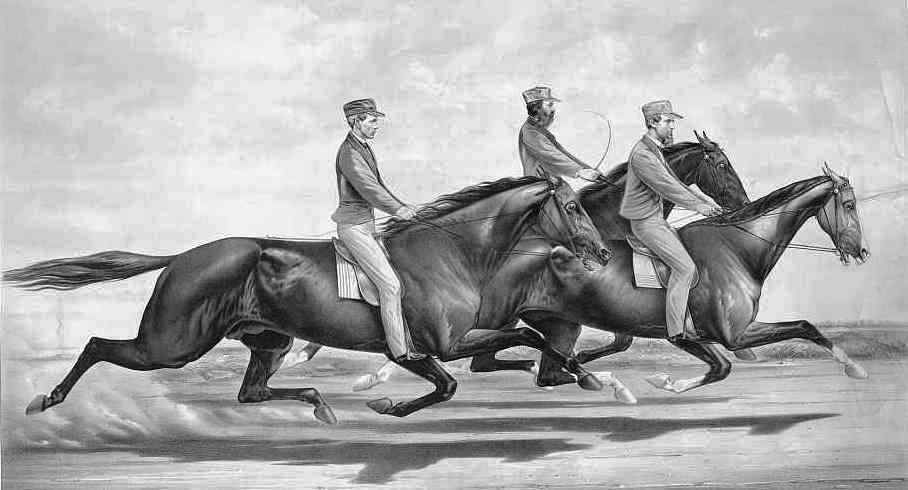
[Before the Standardbred became a breed, Toronto Chief CP (Canadian Pacer), Ethan Allen MO (Morgan) and General Butler AT (American Trotter) fought it out in a trotting race on Long Island, NY. All these breeds and more are part of the modern Standardbred. Currier and Ives print]
So, let's examine durability and soundness in the Standardbred, as demonstrated by those horses that have won over 100 races, the working thesis being that a horse that can win 100 races and start the number of times needed to achieve this feat (200 to 600 races) is an exceptionally sound and durable horse.
The first obvious indication we see from the examining the racers is there is a higher percentage of pacers (87.5%) versus trotters (12.5%) who have achieved this benchmark. As we mentioned in the introduction, even when adjusting the numbers to account for an even amount of trotters in the racing population in North America, a full 3/4 of the centurions are still pacers.
Standardbreds are remarkably sound, with strong legs and hooves, good conformation, hardy constitution, especially when we compare them to other breeds more commonly used in Olympic style sports and in the breeding of sport horses such as Thoroughbreds and warmbloods (Kirsan 2017). One fairly common fault found in the breed, however, is a propensity for OC (osteochondrosis) and it is looked for in young horses and often treated by micro-surgical removal of a bone chip before a racing career begins with overall positive results. Recently a study was published (McCoy et al 2015) on the success of pre-racing treatment of OC and in doing so it provides us with some interesting information, that might also relate to what I noticed in our group of long-lasting racers:
"While pacers and trotters exhibited difference in race performance (as expected), including slower record times and fewer starts in trotters when compared to pacers, OC status did not seem to affect performance outcomes in horses of either gait. Unexpectedly, trotters were significantly more likely to be affected with OC than were pacers.....Our data largely supports previous reports regarding performance difference between pacers and trotters. Trotters were slower than pacers, were less likely to start a race, and started fewer races in their 2 year old season....Since pacing is naturally exhibited by young pace-bred Standardbreds prior to the onset of training, it is possible that the bio-mechanical differences between pacing and trotting could affect the manifestation of OC, as well as impact its effect on performance. There are at least 3 reported differences in the bio-mechanics of the trot and the pace that may have biological significance. An alternative explanation could be that genetic risk factors vary between pacers and trotters, leading to the differences in disease prevalence and lesson distribution." (McCoy 2015, p. 11, 9)
Standardbred Base
As you can see (above) science isn't sure about the origin of the notable difference in performance and soundness either: Is the racing fitness between pacers and trotters a genetic factor (descending from an ancestor more common in the trotting lines) or is there a mechanical predisposition to joint damage in trotters versus pacers? And a different study claims that it is nutrition that is largely to blame (KER 2003). As of today all we can be sure of is there is appears to be a measurable difference in performance and soundness between the two types. We will leave the study of the mechanics of the gaits and nutrition as a possible factor to others. This study will research the bloodlines in dominance, and the historical records on the ancestors who seem to be setting type.
In Standardbred bloodlines certain foundation lines are associated with each version of gait. Messenger EH (English Hunter) for instance was noted for his ability to transfer clear square trotting form along with stamina, size increase, bad temperament and hoof problems on our pacing Running Horses, and his great grandson Hambletonian AT (inbred to Messenger EH 3x4x5x4x4x4) set a strong trotting type as well--neither was remarkably fast. Usually you will find Messenger EH listed as a full Thoroughbred in most literature and in online databases. The truth is he was not even close to the requirements to be called a Thoroughbred. John Wallace discovered his damline was entirely fabricated, and since that time it has been learned that his sireline was very mixed-bred as well, there is even an English cart horse line coming up Sampson's damline (precursor to the Shire Horse) and I feel the evidence also reveals Coach Horse inroads also (read full discussion in Standardbred Sport Horses). All that aside, Messenger EH is still one of the greatest sport horse sires ever imported to this country, and his genetic reach (whatever the components) are woven into the fabric of the Standardbred. The harness breeders wanted a clean trotting action and he provided it.
On the other hand, a clear fast pace along with sturdy conformation, stamina and soundness, ability for long campaigns and sweet disposition was noted in the progeny of Copperbottom RH, Tom Hal RH, Blackburns Whip RH, Hiatoga RH and their descendants, who established pacing families that eventually made their way into the Standardbred stud book (1891). Most Standardbreds have bloodlines of both types, and we will use pedigree analysis (Tesio Methods) to determine which bloodlines are dominant in each horse, with the goal of finding the likely genetic carriers of these resilient traits.
Looking at the pedigree designs of our 24 racers I noticed there was a wide variation from quiet pedigrees with little duplication of bloodlines all the way to extreme inbreeding-linebreeding, although every pedigree had some focal point configuration (potency indicatior), but the amount was not the key element. I turned then to determine the leading dominances in each lineage by saturation (critical mass) and presence of close relatives (siblings), and that is when specific bloodlines became apparent as ruling the type of each performer.
I built out the pedigrees of each horse, extending all the bloodlines until they vanished in the 17th and 18th centuries (1600s-1700s). (I began the practice of extending sport pedigrees all the way back to their termination a few years ago in order to determine what these typesetting horses and breeds arose from. I found in doing this discipline it gave me great understanding on the roots of sport ability). Unfortunately, the further we go back in time, we find pedigree records are often spotty and many times the dam lines were left unrecorded, leaving us with skewed information on true genetic dominance in early bloodlines. For example in the majority of Messenger's 1000 progeny, the dam line and dam sire are often not recorded leaving the impression that only Messenger's genetics were responsible for the offspring's talents.
Several trends appeared right away. There are common root dominance in all the lineages via Hambletonian AT and his son George Wilkes AT (American Trotter--the pre-Standardbred trotting breed) who are at "critical mass" in most horses, as well as in the sport horses I studied for Standardbred Sport Horses. Critical mass is the point where the saturation of bloodline becomes so great--no matter how far back, that it influences type and performance. The breed itself as a whole now is reflecting an overwhelming George Wilkes AT type--which in my opinion is why it is so fantastic in sport of all kinds--he was a tremendously talented and tireless athlete.
George Wilkes' dam is unrecorded and when his excellence as a sire was realized a massive search for his dam's pedigree was conducted. Sadly the outcome was that nothing reliable was ever found. She remains a mystery to this day. George Wilkes AT, who so little resembles his typesetter sire Hambletonian AT in type and performance, had to have a very potent dam to set a type so unique to him because to do this she had to overpower the potency of the extremely inbred Hambletonian AT. The proof of her own potency is that she was able to stamp his genetics with dual-gaitedness, sweet temperament, speed and soundness, so strongly that he was able to pass his own distinct type on reliably.
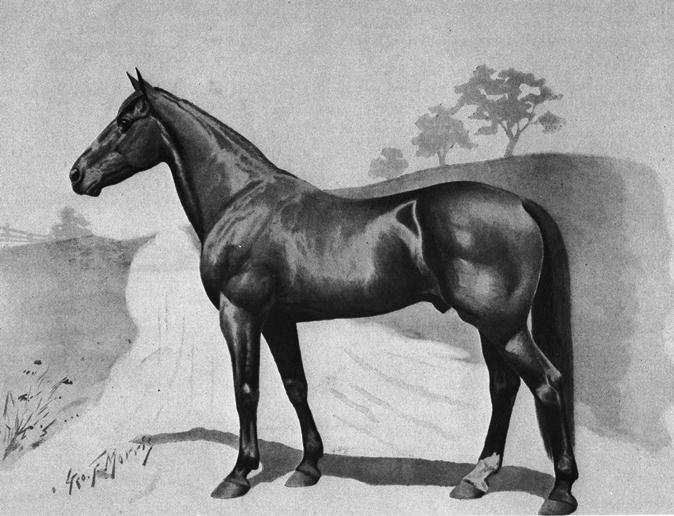
[George Wilkes AT 1856, he is at critical mass in the horses that made our list, and he is also the strongest line of Hambletonian AT found in Olympic style sport horses.]
George Wilkes AT is listed as a trotter but the truth is he was equally able at the pace; he was truly and cleanly dual-gaited, that is, he could pace and trot with clear gaits and speed equally, plus he was noted for producing pacers as well as trotters. His progeny could be dominant in either gait, but most importantly, they were clean and balanced in motion. They could hold a balanced, clear trot for an entire race or they could hold a clean, balanced pace for the entire race, or in some cases could do both, just like he could. Dual-gaitedness is different from when a horse has 'mixed gaits', which means he switches back and forth in a race or in harness from the trot to the pace and back again, Dual-gaited horses don't switch like that; they either are trotting or pacing for the entire race. He also passed on a sweet, quiet, willing temperament and soundness--he raced for a dozen years and retired sound.
Many of the early champions of the pre-Standardbred breed were dual-gaited, examples like Topgallant RH, a champion of the early 1800s who could race at the pace, gallop and trot, and Blackburns Whip RH, a sire so great and reliable for speed and clean gaits of all variations that he is a major root line in the Quarter Horse and American Thoroughbred as well as the Standardbred. Later champions in both gaits are Nancy Hanks ST and Jay-Eye-See ST who set a world record in both gaits. George Wilkes AT produced 3 offspring that held standardbred in both gaits.
We expect Hambletonian AT and his grandsire Messenger EH to dominate in the background lines because they delivered a powerful trot typeset on the early gaited Running Horse mares, and that was what was being selected for by the breeders of the day in the northeast. It was common to only record the Messenger EH lines in the early American Trotter, leaving the false impression that only he provided the performance, and it plays havoc on us trying to determine "critical mass" potency. Often when I tabulate a pedigree of his descendants for 10 generations, the horse with the highest percentage is the "unrecorded" horse.
But not everyone in the early and mid-1800s was breeding trotters, and the states of Ohio, Missouri, Indiana and Tennessee were proudly breeding pacing stock. Usually the pacers raced under saddle in their own meets because they were banned from the trotting harness tracks. Pacers were valued not just for great racing talent but because they were also the best source of comfortable and able saddle horses. The pacers made great mounts and they were the preferred hunter horse in the the region. And once the Civil War began it was the pacers that were ridden off to war first by the cavalry. Somehow from the remnants of the conflict enough of the pacers, some with unknown parentage, returned to start the pacing industry again. It is from those surviving remnants that the bloodlines we find today behind the majority of the sound and tenacious racers we are studying.

[Figure RH 1789, the foundation sire in the Morgan, he was also very influential in the Canadian Pacer and later Standardbred through lines of Copperbottom RH and Sherman Morgan MO (sire of Black Hawk MO), both out of a Narragansett Pacer dam. 10% of the modern Morgan is gaited.]
Pacing elements arrived via northern New England and Canada, plus from the Maryland-Virginia studs. From the north came the bloodline of Copperbottom RH and his descendant Old Pacing Pilot RH which became one of the pillars of the developing Standardardbred, as well as in our saddle horse breeds. Copperbottom RH was a son of Figure RH, the foundation sire of the Morgan breed out of a Narragansett Pacer dam and he became a foundation of the pacing RH and the Tennessee Walker. (I label Copperbottom "RH" rather than "MO" for two reasons: 1-he was a racehorse, and 2-he was not a foundation for the future Morgan breed, rather he was a base for the Canadian Pacer and the American Saddle Horse stock, and an important line in the Running Horse. In contrast, his peer Sherman Morgan MO (and possibly his full brother) was used as a foundation for the Morgan breed).
Old Pacing Pilot RH was renowned not just for transferring the fast pace to the racers but he created a dynasty in smooth gaited saddle and sport horses. His son Pilot Jr. AT was tremendous trotting typesetter in Kentucky and the line consistently provided sound, fast racers. We have good information on Copperbottom's sire Figure RH, and he was typical Running Horse breeding in the Connecticut Valley area of his day: early English TB crossed on American Running Horse. Copperbottom's dam on the other hand is only identified as a Narragansett Pacer, which was the Rhode Island bred branch of the Running Horse, and was noted for extreme hardiness for long campaigns, able to carry a rider for 50 to 100 miles day after day, and was very fast on the track, plus it was sound and sweet tempered. They were highly prized as saddle horses and when they were dispersed after the revolution many went north to Canada and northern New England where they were regularly crossed on the Morgan horse. That cross is the genetic base of the celebrated Canadian Pacer and the Morgan families that excel at sport. When Copperbottom RH got to Kentucky he and his progeny were the backbone of their saddle horse industry and the same occurred in Tennessee, which we can see easily in the not just the pacing Standardbred, but the Tennessee Walker, as its foundation sire Bald Stockings RH was by Tom Hal RH out of a Copperbottom RH mare.
Old Pacing Pilot's 3rd sire was Copperbottom RH, but his dam increased those genetics as she was by Voyageur MO who was by Figure RH out of a Narragansett Pacer dam as well, and his second dam was by a grandson of Figure RH out of yet another Narragansett dam, so the base genetics were magnified; therefore he was a typesetter for the Morgan-Narragansett cross and its benefits.
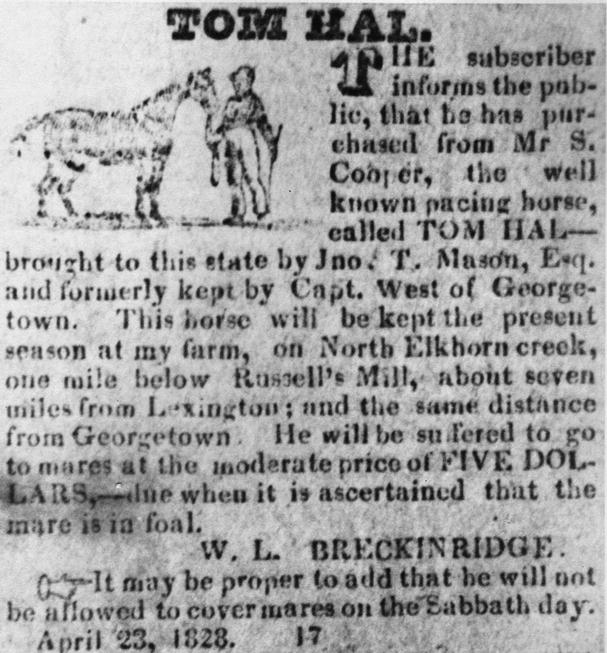
[1828 ad for Tom Hal RH after he was brought to Kentucky from Maryland]
The other main root that shows up in these pacers is based on Tom Hal RH, developed from the early colonial breed of racers descended almost exclusively from the Hobby imports to the Virginia and Maryland colonies, commonly referred to in literature of the day as the Native American Woods Horse.
Tom Hal's ancestors were not recorded, but we can see the traits he passed on so consistently were present in his ancestors and contemporaries: fast pace, soundness, stamina, easy keepers, friendly and willing dispositions. Here are some excerpts from reports made on their breed (Maryland-Virginia were united in the creation of this strain.)
"more beautiful in form and active in spirit than the English breed." (1620 report found in "Declaration of the State and the Colonie", collected in Peter Force's Tracts vol. III, p. 5)
The official reports sent to England for the London Company (investors in the Virginia colony) in 1624 says that every resident plantation owner (11) and the governor were breeders and/or owners of racehorses. (Hervey, 1931, p.8). For perspective: The 1624 race horse breed (Running Horse) was 50 years before a Thoroughbred breed existed, using Spanker as the first true Thoroughbred= 1690, and in addition was 106 years before the first Thoroughbred arrived in America (1730).
A century later in 1724 visiting Englishman Hugh Jones reports:
"The saddle horse, although not very large, are hardy, strong and fleet (emphasis mine) , and will pace naturally and pleasantly at a prodigious rate." (The Present State of Virginia).
If we fast forward past the time of Tom Hal's life to our Civil War, we find the horses found in the Maryland-Virginia areas are still of the same consistent type: "The short barreled, wiry Virginia horses, almost as tireless as Army mules, proved them far superior for active service." (Harper's Weekly February 1864). With both the Morgan-Narragansett typeset (Copperbottom et al) and that provided by the Maryland-Virginia RH so influential in the dominance of these leading lines, we should be paying close attention to their genetics.
Perhaps then we have some clues here from the historical reports, about the abilities these wonderful 24 modern day Standardbreds exhibit, appears to have traveled down the genetic trail from our colonies' finest horses to them. (A full history of our sport horses that became the Standardbred is provided in Standardbred Sport Horses).
Rather than link all the pedigrees to this page, I will list all the 24 Standardbreds by name, year of birth below with their leading dominance indicated and then secondary dominance in parenthesis, plus the generation position of the closest linebreeding, so you an get an overview of what was powering their remarkable performance record without being overwhelmed by the amount of data. The 3 Trotters in the list will be identified by (T). Full siblings will have a '/' separating them, and the dominant horses will be separated by a comma with the strongest strain on the left side or if of equal genetic weight with a '-'. The linebreeding noted is merely the closest, not the only pattern in the pedigree.
24 Durable and Sound Standardbreds
Name-dob Leading dominance secondary dominance closest dup.
Paleface Adios 1969 Peter the Great (Guy Axworthy, Peter Volo, Guy Wilkes) 3x4
Rambling Willie 1970 Hal Dale (Peter the Great, Peter Volo) 3x3
Good Bye Baron 1971 Adios/Prashai/Adieu (Hal Dale-Adioo Volo, Peter Volo) 2x3
Wil Lor Gary 1971 Calumet Chuck (Guy Axworthy, Peter the Great, Grattan Royal) 3x4
Lindsay N 1973 Peter the Great (Axworthy/Marguerite A) 3x5
Niffit 1975 Peter the Great (Guy Axworthy) 3x2
Columbia Luke 1975 Hal Dale-Abbedale (Peter the Great, Billy Direct) 3x4
Heisman 1975 Adios (Hal Dale, Volomite) 4x2
Cane Smoke 1976 Hal Dale (Volomite, Peter the Great, Adioo Volo, Peter Volo) 3x3x4
Worthy Gift 1978 U Scott (Volomite, Adios) 4x4
Mannart Tornado 1979 Adios (Hal Dale, Volomite Peter Volo) 4x5x3
Breeze On J 1981 Peter the Great (Guy Axworthy, Axworthy, Santos) 3x6, 3x5
Rapunzel's Star 1983 (T) Peter the Great (Axworthy, Guy Axworthy, Scotland) 4x4
Stacey's Echo 1984 Adios-Good Time-Hal Dale (Volomite, Peter the Great, Scotland, Peter Volo) 3x4
Bestdealintown 1986 Adios (Peter the Great, Volomite, Adioo Volo) 3x3
Mr. Charm 1990 Adios (Peter the Great, Volomite, Adioo Volo) 3x6, 4x4x4
Pilgrims Fiery 1991 Adios (Hal Dale, Peter the Great, Guy Axworthy, Peter Volo, Volomite) 4x5x6, 4x6
Jerry's Cadet 1992 Adios/Adieu (Hal Dale, Abbedale, Billy Direct, Peter the Great) 3x4, 3x4x4
Crafty Sailor 1993 (T) Speedster (Rodney, Guy Axworthy, Peter the Great, Axworthy, Volomite) 3x3, 4x3
Bingham 1995 (T) Peter the Great (Scotland/Rose Scott, Darnely/Highland Lass, Guy Axworthy) 4x4x5
Tattlers Jet 1998 Adios/Adieu (Shadow Wave, Tar Heel, Hal Dale) 3x3x4
Whata Terror 1998 Most Happy Fella (Hal Dale, Bret Hanover, Good Time, Adios) 2x1, 4x4x3
Destreos 2003 Abbedale (Volomite, Albatross, Guy Axworthy, Adios)
5x6x5x4, 5x6x5x6
Foiled Again 2004 Abercrombie (Tar Heel, Hal Dale, Meadow Skipper, Albatross) 3x2, 3x4, 3x6
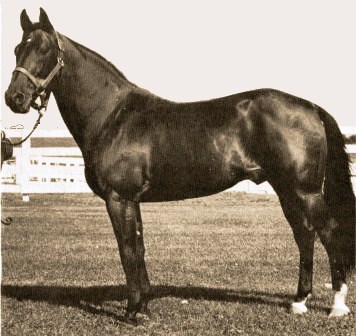
[Adios ST, a mega-sire in the breed, he is the leading dominance in our horses of soundness and durability, he is also a strong potency in Standardbreds that excel in Olympic style sport.]
2020 update: Two mares can be added to the study: Rusty's Flying and Lady Netty N.
Rusty's Flying 2008 Hal Dale (Adios, Meadow Skipper, Volomite) 3x4, 3x5
Lady Netty N 1988 Volomite (Light Brigade, Peter the Great, Hal Dale) 4x4
Both pacers.
As you probably noticed a few individual lines stand out as being dominant over others less indicated. In leading dominances clearly Adios ST (and his full siblings) with 9 instances is the most reliable line for producing this performance. Peter the Great ST even being born in 1895 reaches forward and by critical mass leads in 6 horses. Hal Dale ST, the sire of Adios ST, himself leads in 4 and his sire Abbedale ST in 2 more. The other individual most dominant horses (U Scott, Abercrombie ST, Most Happy Fella ST, Good Time ST, Speedster ST, Good Time ST, Calumet Chuck ST) you will see shortly are extensions of the original main sources. Looking at the secondary potencies several lines are appearing in strength: Volomite ST and Peter the Great ST are 10 each, Hal Dale ST and Guy Axworthy ST and Peter Volo ST are 8 each, Axworthy/Marguerite 4, Adios ST and his dam Adioo Volo ST are 3 as is Scotland ST. Billy Direct ST, Albatross ST and Tar Heel ST are 2 and Guy Wilkes ST, Grattan Royal ST, Santos ST, The Abbe ST, Rodney ST, Darnley/Highland Lassie, Shadow Wave ST, Bret Hanover ST, Meadow Skipper ST are 1 each.
Before your eyes glaze over from the amount of data I just dumped on you, it might help to divide the influences into family groups for ease of understanding, because all these lines can be gathered into just 3 families: Peter the Great ST is the sire of Peter Volo ST who in turn the sire of Volomite ST, and Peter the Great ST is also the sire of Peter Scott ST who is the sire of Scotland ST, who in turn is the grandsire of Rodney, who is the sire of Speedster ST. Santos is the dam of Peter the Great ST.
The Abbe ST is the sire of Abbedale ST, who is the sire of Hal Dale ST who in turn is sire of Adios ST, Good Time ST and others, plus Adios ST is sire of Bret Hanover ST (who won 61 out of 64) and Shadow Wave ST and their descendants such as Albatross ST (who won 59 out of 71) and is by Meadow Skipper ST out of a Adios-Tar Heel dam. Meadow Skipper ST descends from the Hal Dale ST line on both sides of his lineage. Tar Heel ST is related closely to both Billy Direct ST and Hal Dale ST. Abercrombie ST is strongest in Abbedale ST, Peter the Great ST and Billy Direct ST.
Axworthy ST carries a Saddle Horse, Morgan and Trotter mix in his lineage, and he is sire of Guy Axworthy ST who is out of a Guy Wilkes ST dam.
[Note on American Saddle Horses: all of our light horse breeds, our saddle horses, arose from the same Running Horse genetics as our racehorse breeds, therefore they are sport horses as well, and besides many of them could race as well as win in saddle competitions.]
I will provide a 7-generation pedigree of the driving dominance of the racers below--click on name with blue line to bring up the pedigree. There are 3 major bloodlines that are represented: Hal Dale ST and his son Adios ST are the strongest presence through descendants like Most Happy Fella ST, Second in potency is Peter the Great ST and his son Peter Volo ST usually through his son Volomite ST, and Peter the Great's son Peter Scott ST through Scotland and Speedster ST.; and third in dominance is Axworthy ST and his son Guy Axworthy ST
Breed labels can be confusing, and most often in online databases you will see all the ancestors listed as 'Standardbred' (ST), but the Standardbred did not become a breed until 1879, and only with the Trotters listed, and then in 1891 the pacers were brought in as well. The pre-Standardbred racers were the American Trotter (AT) which became a breed in 1818 when a 3-minute mile standard was set for the breeders, and then it was adjusted in 1871 when the standard was changed to 2:40 mile. The pacing Running Horses, which were our original colonial breed, was timed at 2:30 in approximately 1740, with two main branches: first the Virginia-Maryland Running Horse (aka Native American Woods Horse), which was documented as a racing breed from 1624 and the slightly later Narragansett Pacer branch, which arose sometime between 1680 and 1690 when a performance test was established for their strain. And they are two branches of the same breed, not separate breeds as many have surmised--they interbred and competed with each other. The Morgan (MO) was a breed from approximately 1820; the foundation sire Figure RH (aka Justin Morgan) was a New England RH. The early sprint racers both galloped and paced, and the horses of the sprint studs of Virginia raced both ways: gallop and pace.
Our American Thoroughbred is different from every other TB population because it contains American RH as well as English TB, and many important bloodlines in the Standardbred came from the Running Horse Boston, his son Lexington RH, and his grandson Planet RH---we will see these lines as examples of soundness and durability in the Part Ii Thoroughbred discussion. All three of these exceptional sires of the heat racing galloper, were also able to produce trotters, and Planet RH was a confirmed trotter, and he preferred to move at that gait, yet he was the greatest galloping 4-mile heat racer of his day. All three have multiple lines of the trot typesetter Blaze through his daughter Cypron as well as having pacing lines from the Virginia studs. The imported Messenger EH (English Hunter), contrary to common literature was not a full TB. And further, the English Thoroughbred had both pacers and trotters in it early on and the early Thoroughbred Blaze 1733 produced many trotters and is considered the foundation sire of the Norfolk Trotter, and he is the great-grandsire of Messenger EH as well. All the colonial and later history is given in detail with full documentation in Standardbred Sport Horses. I have made it a point to correct breed labels whenever I can so we can see where the sport talents we so admire and desire originated from (see breed history page for an outline of American breed development).
Main Dominance Bloodlines
Hal Dale ST line
So let's get to it. Hal Dale ST is the sire of Adios ST, Good Time ST and Dale Frost ST among many others. He was a pacer by Abbedale ST who is 3x4 to Electioneer AT through sons, and he is out of Margaret Hal ST who is 3x3 Gibsons Tom Hal RH sex balanced (pacers (RH) were not entered into the Standardbred register until 1891), with his sire Bay Tom RH 5x6x5 and the Saddle Horse (ASA) Pat Malone ASA 6x5. Saddlehorses were a breed of their own by 1817, and were gaited, and many could race as well. Hal's is a male leaning pedigree, better for sons than daughters, If you pull up his pedigree you will see some of the root pacing sires of significance discussed above.
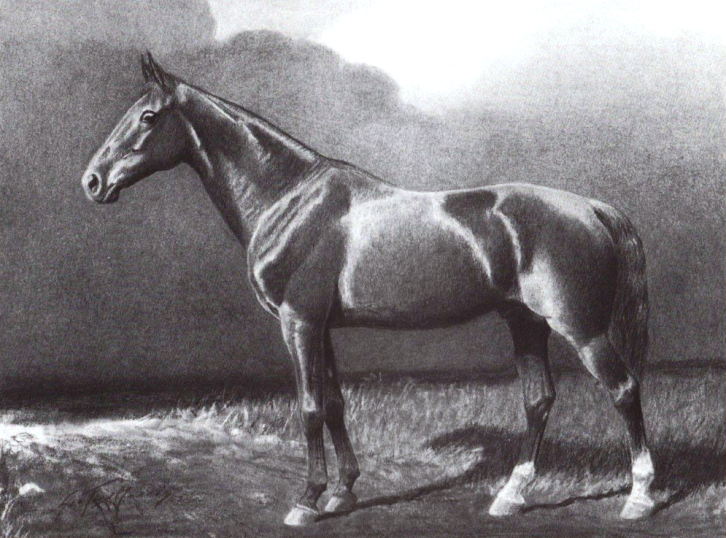
[Gibsons Tom Hale RH 1862, who Hal Dale's dam in inbred 3x3, and is partially responsible for the surprising success of this bloodline.]
Abbedale ST, the sire of Hal Dale ST was 3x4 to the trotter Electioneer AT, a good sire of trotters, yet Electioneer AT bewilders us with a strong secondary pacing dominance himself. Of course he was most potent in Messenger EH and he was a trotter, but he threw a significant number of pacers or dual-gaited horses as well, such as his best son Chimes ST. We can identify a pacing influence arriving with Jary's Bellfounder NT (Norfolk Trotter, aka Hackney). Bellfounder was the only Norfolk that left a lasting impression on our Standardbred gene pool. He was by Stevens Bellfounder NT out of a Thoroughbred dam. Common industry wisdom would assume then that Bellfounder was a straight trot transmitter, but that is not what I have found, rather it seems he has a hidden pacing dominance coming from inbreeding to the early Thoroughbred mare Miss Hervey and I have found evidence that she was either gaited herself and/or transferred the pace to her progeny (See Standardbred Sport Horses for the full story). Plus Electioneer AT also had Irons Cadmus AT, who transmitted gaits, and there is Johnsons Copperbottom RH, a strong pacing line, plus the 5-gaited speedster Blackburns Whip RH. The point is Electioneer AT, a trotter, also had a secondary pacing factor.
Hal Dale ST is when Electioneer AT line tipped strongly into a pacing line. Hal Dale ST was not completely sound himself (tendons) and because he was not highly thought of he was not even raced until he was 6. When he did get out on the track he impressed them all with his speed. His excellent way of going: low motion with little knee action proved extremely effective and he burned up the track. Retired to stud and given low level mares he still was able to transmit his superior technique along with his short stature, stocky short-coupled frame with a well muscled hindend. His stock, especially his sons proved first rate and his potency allowed his gifts to leave a lasting type on the breed. For example, the great modern racing racer and sire Cam Fella ST is 4x4x4x4 to Hal Dale, it is his strongest potency.
You can see it in the design of Gibsons Tom Hal RH, a pacer, has become the most dominant influence in Hal Dale ST, edging out Electioneer AT who occupies second place of potency. Hal Dale ST brings in the powerfully pacing dynasty of Tom Hal RH who was directly descended from the original Hobby imports to the plantations of Virginia and Maryland, and Copperbottom RH who represents the Narragansett Pacer and Morgan genetics.
The weight of the pacing line contribution increases when we consider that Peter the Great's dam Santos ST had significant potency in the Morgan-Narragansett lines as well, as does Axworthy ST.
Adios ST is the most successful son of Hal Dale ST and is by Adioo Volo ST, who herself is a secondary dominance in this list. Her lineage explains fairly clearly why Adios ST was the best son of Hal Dale ST. Adioo Volo's sire was 2x1 to full sisters: By Guy/Adioo, and Adioo Volo's dam, Sigrid Volo ST, brings in their 3/4 brother Chitwood ST, who carries the reverse sex-balance of each line: Nutwood AT and George Wilkes AT. The parents of these full siblings carry reinforcements for the original elements for the pace, and the trot. Nutwood AT is interesting because he is out of a conduit of Narragansett-Morgan via Old Pacing Pilot RH, and Guy Wilkes's dam carries Virginia pacers Cockspur RH and Blackburns Whip RH. This configuration is astoundingly potent and definitely is the reason Adios ST and his full sisters: Prashai and Adieu (and 7/8 sister Overbid) are so very powerful not only here, but in the entire modern Standardbred. Adios ST is a line that has also shown up in power in the Standardbreds that can perform well in Olympic style sport, even in dressage horses and international level jumpers; it is a top rate sport bloodline.
Notice also Peter Volo ST, a strong trot transmitter, but he too has a secondary pace dominance as well, especially via Pilot Jr AT lines.
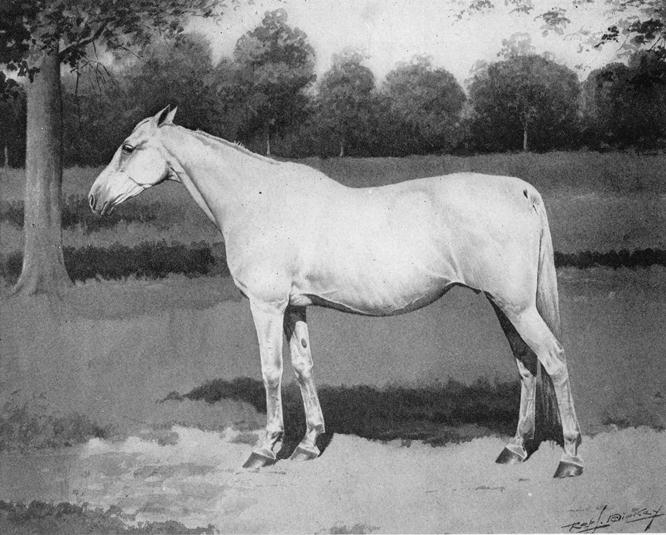
[Miss Russell AT, one of the greatest foundation mares of the breed was by Pilot Jr AT out of Sally Russell AT, a daughter of Boston RH. She produced champion pacers and trotters.]
The background of both the sire and dam have lines in common that build on the potency with a total of 9 lines of George Wilkes AT, multiples of Nutwood AT and his 3/4 sister Lady Russell ST, both out of Miss Russell AT, one of the most successful foundation mares in the modern breed. Her sire Pilot Jr AT, a trotter sired by a pacer: Old Pacing Pilot RH, who is 2x1 to Jeanne De Arc RH, one of the foundation mares of the Canadian Pacer; it is notable that this tight inbreeding pattern of mares is repeated by the damsire Adioo Guy ST with his 1x2 inbreeding to full sisters: By Guy ST and Adioo ST. Inbreeding sets type.
Adios ST crossed with another stallion that appears as a secondary potency, Tar Heel ST (son of Billy Direct ST--see combined pedigree), and together they were so perfectly matched genetically because they provided the opposite sex balance for their main bloodlines and together they became known as the "golden cross" because designing a pedigree with both of them was almost a guarantee of racing perfection. Billy Direct ST and his son Tar Heel ST are secondary dominance as well.
The great grandson of Adios ST: Abercrombie ST also carries reinforcement of Adioo's inbreeding to the full sisters Adioo/By Guy with an additional 2 lines of Adioo ST via Dorsh Hanover ST and Miss Saginaw ST. There is a double of Nibble Hanover ST, a son of Calumet Chuch ST, who himself is the first potency in another of the racers. Abercrombie ST is rated a sound line on its own (he is a lead potency in our modern hero Foiled Again ST).
Most Happy Fella ST, a leading dominance in one of the horses, carries both the Hal Dale ST sons Good Time ST and Dale Frost ST lines through sons, with backup dominances of the Peter Volo ST son Volomite ST...a trotter who produced an equal number of pacers and trotters, plus multiple lines of Guy Axworthy ST (tremendous sport bloodline that is often found potency in jumpers). Two of the offspring of Volomite ST are 3/4 siblings (Kings Counsel/On Time) 3x3 out of Guy Axworthy ST dams making their presence felt in the performance and phenotype. These two trotter lines: Peter Volo-Volomite and Guy Axworthy ST are power lines throughout the breed, and are found in both trotters and pacers in multiples. This possible swing back to the trotters was balanced once more by two lines of the pacer Walter Direct ST 6x5, who bolsters the Hal Dale ST strength in Gibsons Tom Hal RH, as he brings in the sister and daughter.
Peter the Great line:
Peter the Great ST was a puzzle for the traditional trotter breeders of his day, and they did not like him. He was mixed-gaited, that is, he would switch back and forth between the gaits and could not be trained out of it, and then he lamed and was hard to sell--no one wanted him. Yet he became the greatest stallion the breed ever had, way surpassing the progeny record of both Messenger EH and Hambletonian AT. His record of standard performers was only approached by his son Peter Volo ST, but even he was 20% less. His offspring were consistent winners, and he produced both trotters and pacers. His main dominance of course is Hambletonian AT, but its interesting his second most powerful genetic factor comes via Pilot Jr AT and other closely related lines. Pilot Jr AT was a son of Old Pacing Pilot RH, the prototype for the Canadian Pacer. Pacing Pilot RH, was just that, a pacer, and he was bred in Canada and was tremendously inbred to Jeanne de Arc RH 2x1, and she was a Morgan-Narragansett Pacer cross, as was Sherman Morgan MO and Copperbottom RH and Davy Crockett CP (Canadian Pacer). Davy Crockett CP also makes an appearance in this lineage and makes the Pacing Pilot RH line stronger because he carries the opposite sex balance (like Walter Direct ST did for Gibsons Tom Hal RH and like Chitwood ST did for Adioo ST and By Guy ST.) Other Morgan lines buildup in 3 of Putnam Morgan and one of Bulrush Morgan coming from his top rated dam, Santos ST, who had other stallion sons. So this horse carried great trotting typesetting as well as powerful pacing typesetting...quite a jumble, and he was mixed-gaited. Yet, he is the greatest sire there has ever been in the breed. (All of these bloodlines are discussed in depth in Standardbred Sport Horses.).
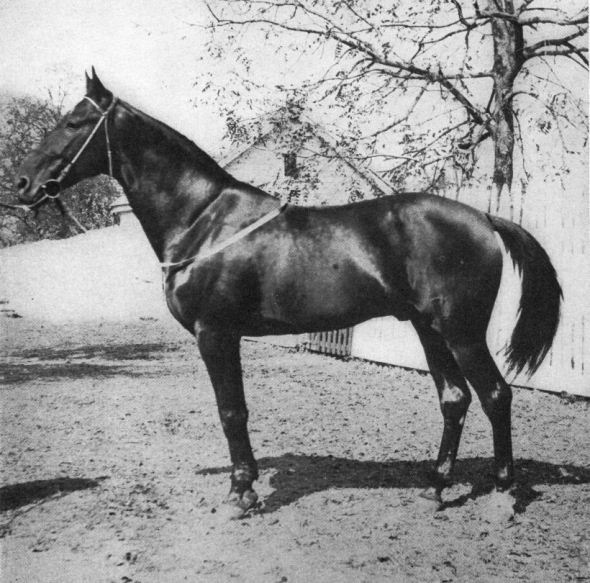
Peter the Great ST had over 2000 offspring, but two of his many sons head powerful dynasties, Peter Volo ST and Peter Scott ST. While Peter Volo ST and his son Volomite ST are found in the entire breed in power, Peter Scott ST is more often found in the trotting lines. In the three trotters in this list Peter Scott ST makes a strong appearance as dominant via his son Scotland ST who is listed as dominant and also is the sire or grandsire of the main potency of Darnley ST and Speedster ST. Peter Scott's dam added three more lines of Hambletonian AT and two of Mambrino Chief AT, typesetters of trot. Scotland ST is a super star, and his dam while adding more of the same elements, also is 3x4 to the full brothers Alcyone AT/Alcantara AT who are by George Wilkes AT out of Alma Mater AT, with a 3/4 sister, Annabel AT. Scotland ST is one of several full siblings including the very commonly seen Rose Scott ST.
His son Darnley ST is dominant, and his dam brings in Guy Axworthy ST and 2 sisters (daughters of Axworthy ST). His great grandson Speedster ST, one of the power lines in the breed, shows up here also and his own dominance is Axworthy ST and his son Guy Axworthy ST (see below).
Peter Volo ST, a fantastic sire in his own right, and he also had a full sister Volga E ST who is often seen in pedigrees. Peter's dam brought in potency in George Wilkes AT, and with it the ability to transmit clear correct gaits no matter the form. He is 5x4 to George Wilkes AT through sons.
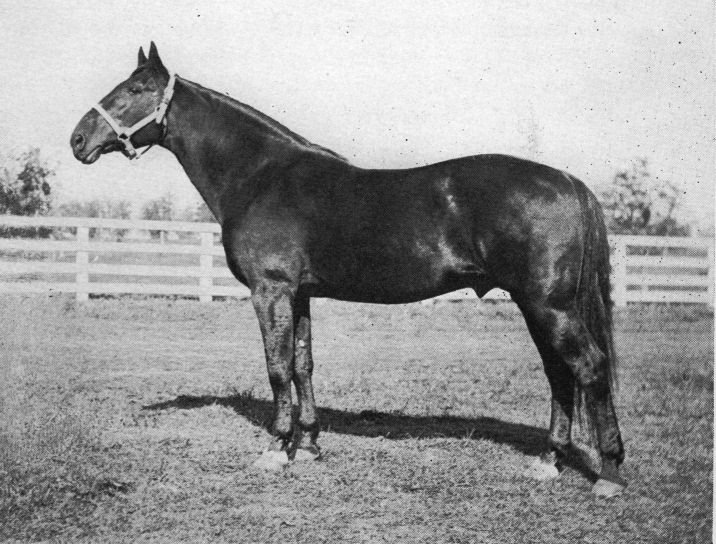
[Peter Volo ST -- strong line of speed, stamina and soundness.]
Volomite ST is Peter Volo's best son, and he was a trotter like George Wilkes AT in that he produced both pacers and trotters that made standard. Here is what I wrote about his genetics in Standardbred Sport Horses : "Volomite's strengths are not as apparent as those of Scotland--at least not at first glance. There is a definite shift in components, as more Running Horse and Narragansett-Morgan are brought in with multiples of Nutwood AT (Boston RH-Pilot Jr AT) and the second dam carries strong Glencoe TB and American Eclipse RH lines. There is lots of George Wilkes AT, of course, including Alycone ST and an interesting buildup of key mare: Dolly AT, the dam of Onward ST and also of Director AT, and a double of Lida W ST, a Nutwood AT daughter, the dam of Nutwood Wilkes ST and Direct Line ST."
Nutwood AT, who keeps showing up in key spots in the background of these horses, is quite the broodmare sire, as he is the sire and damsire of the power inbreeding in Adios ST: By Guy/Adioo and Chitwood ST.
Axworthy ST -- Guy Axworthy ST
Axworthy ST and his son Guy Axworthy ST are found throughout the breed and are notable here in the resilient racers, and because they (like George Wilkes AT) were reliable for transferring a clean clear gait on what they were crossed with. Axworthy ST was one of the greatest sires of the last century. His sire Axtell ST was inbred 3x3 to Mambrino Patchen ST, a confirmed pacer, whose sireline is in dispute, and I devote quite a bit of space to that issue in my book, and have decided the evidence points to Gaines Denmark ASA (American Saddle Horse) as his sire rather than the more usually attributed Mambrino Chief AT. Mambrino Chief AT was a trot typesetter and a coarse and homely horse with some unsoundness (see Standardbred Sport Horses for details and documentation). A strong Morgan-Narragansett influence arrived via his sire's second dam. Axworthy's dam brought in more Morgan and gaited Running Horse as well as another line of Mambrino Chief AT.
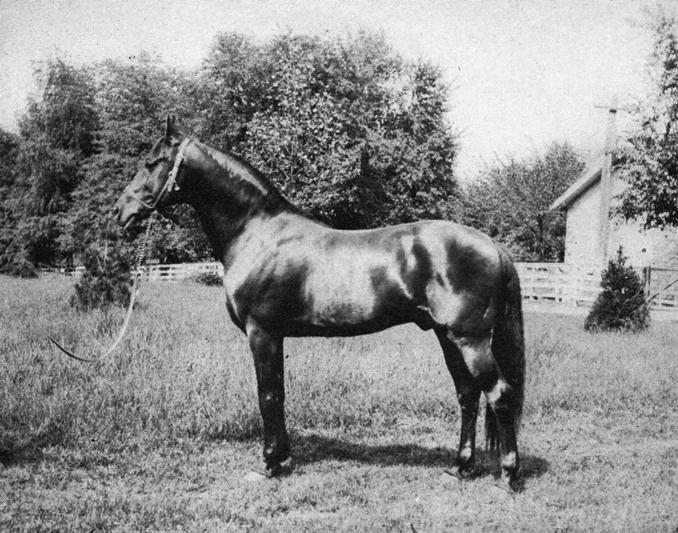
[Guy Axworthy ST---note the square balanced conformation, it travels consistently down the genetic trail from George Wilkes AT.]
Guy Axworthy ST is a mega-sire, and he brought the full brother to Axtell's sire William L AT: Guy Wilkes ST, making them 3x2, and the lead potency. The brothers are by George Wilkes AT out of Lady Bunker AT who is a daughter of Mambrino Patchen AT out of a dam with both Morgan and gaited Running Horse. His second dam Flora AT was heavy in Thoroughbred and Running Horse.
Calumet Chuck ST is loaded with George Wilkes AT, Guy Axworthy ST and Peter the Great ST.
Conclusions for Part I:
A large dose of toughness and resiliency arrive first with the genetics of Adios ST and his sire Hal Dale ST, Peter the Great ST and lines of his sons Peter Volo ST and Peter Scott ST, and also via the solid influence of Axworthy ST and especially his son Guy Axworthy ST. Also notable is that even with the pacing genetics only being added to the breed in 1891, it is apparent something aiding soundness and resiliency arrived from the concentrated elements of our native Running Horse. As we saw in the introduction to the study, science has noted a significant soundness and athletic advantage reside in the pacing lines. It is easy to forget our pre-Standardbred trotter also arose from our native racehorse. Perhaps, a genetic dynamic occurred when the concentrated Running Horse elements were reintroduced to the trotters when the pacers entered the book in 1891, energizing the original sound and athletic traits all over again.
Making a potency in your foals from these lines will increase you chances of tough, sound, talented athletes. More insight will come from the examination in Part II of the near relative Thoroughbred and in Part III the Quarter Horse.
References
Force Peter Force's Historical Tracts, vol III p5 "Declaration of the State of the Colonie" 1620
Harper's Weekly, February 1864
Jones, Hugh The Present State of Virginia 1724
Kentucky Equine Review "Bridge the Gap Between OCD and Nutrition" 11/2003
Kirsan, Kathleen Standardbred Sport Horses 2017, Legacy of Lexington 2014, www.sport-horse-breeder.com ("Understanding Pedigrees". "Siblings", "Tesio Methods", "American Breed Development", "Morgan Horse"s, "Standardbred" and "Colonial Roots of the Quarter Horse")
Marrion, Frank "Reflections on Hal Dale" 5/2000
McCoy et al "Short- and long term racing performance of Standardbred pacers and trotters after early surgical intervention for tarsal oseteochondrosis" (Equine Vet Journal 2015 July; 47 (4): 438-444, doi:10.1111/evj.12297)
Weingarten, Ken "Cushing's drive with Foiled Again is something he will never forget" (USTA 9/4/2018)
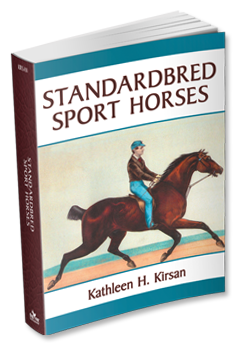
Order Standardbred Sport Horses (20 % discount)
Links to Introduction and part II, the Thoroughbreds, and part III, the Quarter Horse, plus the conclusions drawn from the study
American Running Horse - base stock of all our sport breeds, colonial development
Rusty's Flying - two mares earn the 100 win title